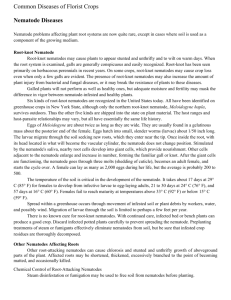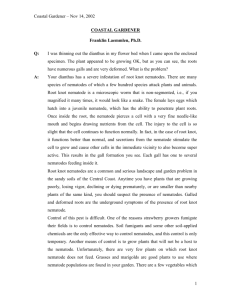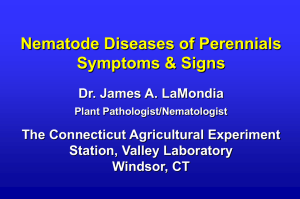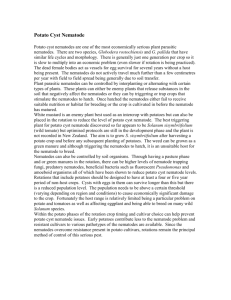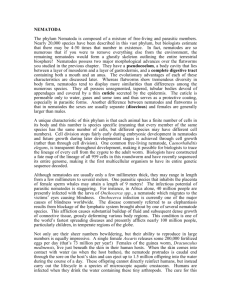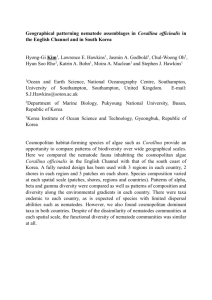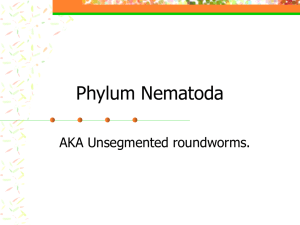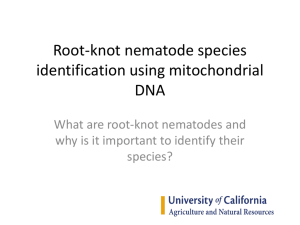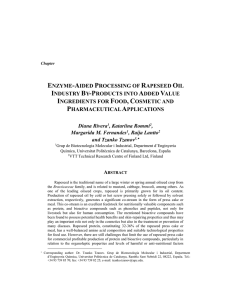Nematode Control Recommendations for Corn 11-2012
advertisement
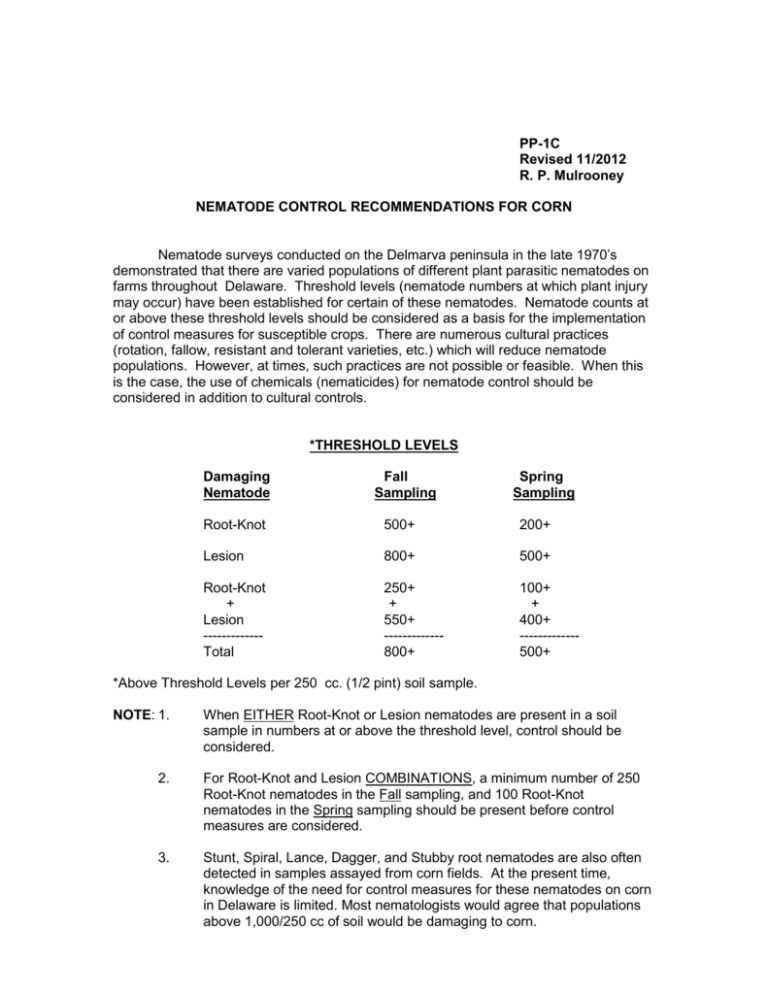
PP-1C Revised 11/2012 R. P. Mulrooney NEMATODE CONTROL RECOMMENDATIONS FOR CORN Nematode surveys conducted on the Delmarva peninsula in the late 1970’s demonstrated that there are varied populations of different plant parasitic nematodes on farms throughout Delaware. Threshold levels (nematode numbers at which plant injury may occur) have been established for certain of these nematodes. Nematode counts at or above these threshold levels should be considered as a basis for the implementation of control measures for susceptible crops. There are numerous cultural practices (rotation, fallow, resistant and tolerant varieties, etc.) which will reduce nematode populations. However, at times, such practices are not possible or feasible. When this is the case, the use of chemicals (nematicides) for nematode control should be considered in addition to cultural controls. *THRESHOLD LEVELS Damaging Nematode Fall Sampling Spring Sampling Root-Knot 500+ 200+ Lesion 800+ 500+ Root-Knot + Lesion ------------Total 250+ + 550+ ------------800+ 100+ + 400+ ------------500+ *Above Threshold Levels per 250 cc. (1/2 pint) soil sample. NOTE: 1. When EITHER Root-Knot or Lesion nematodes are present in a soil sample in numbers at or above the threshold level, control should be considered. 2. For Root-Knot and Lesion COMBINATIONS, a minimum number of 250 Root-Knot nematodes in the Fall sampling, and 100 Root-Knot nematodes in the Spring sampling should be present before control measures are considered. 3. Stunt, Spiral, Lance, Dagger, and Stubby root nematodes are also often detected in samples assayed from corn fields. At the present time, knowledge of the need for control measures for these nematodes on corn in Delaware is limited. Most nematologists would agree that populations above 1,000/250 cc of soil would be damaging to corn. Recommendations for control of these nematodes will be indicated on assay report forms if control is considered advisable. CONTROL MEASURES A. Non-chemical control: Rotation. As far as can be determined at the present time, no rotations are feasible for the Delaware area that will successfully reduce nematode populations to levels considered insignificant for corn. Soil amendments and green manures. In general, the incorporation of large amounts of organic matter into the soil reduces populations of plant-feeding nematodes. The decomposition products of some plants kill nematodes. These include butyric acid, which is released during the decomposition of rye and timothy, and isothiocyanates, released during the decomposition of rapeseed and other mustards in the genus Brassica. Maximum benefit of these”natural” nematicides is obtained when the plant material is incorporated into the soil as green manure. Green manure treatments are not equally effective against all plant- parasitic nematodes and therefore it is important to consult with a diagnostic lab or extension agent to make sure the treatment is appropriate for the nematode being controlled. For example, rapeseed is effective against dagger nematodes but not lesion nematodes. Also keep in mind that varieties of the same green manure crop can differ in the amount of toxic chemical components in their cell walls and therefore differ in the amount toxic by-products released during decomposition. For dagger nematode control, two years of rapeseed green manure is desirable, but it may be possible to get the same benefit by growing two crops of rapeseed within one year. The following timetable is suggested for producing two rotations of rapeseed within one year: • Prepare seedbed and plant rapeseed by late April or early May. (Plant only recommended winter rapeseed varieties.) • Turn under green rapeseed by early September. Prepare seedbed and plant second crop by mid-September. • The second crop should be turned under in late spring after soil temperatures reach 45°F or higher. • Ideal conditions for incorporating the cover crop are similar to those required for obtaining the maximum benefit from fumigation (i.e., the soil should be above 45°F and moist). • Alternatively, planting dates may be reversed so that the first planting is in the fall followed by a second crop planted in the spring. This would end the rotation cycle in fall of the following year. Some rapeseed varieties are more effective at suppressing nematode populations than others, and some varieties will not over-winter or they bloom too early in summer to be useful. The winter varieties ‘Dwarf Essex’ and ‘Humus’ work well for both spring and fall planting dates. If planted in the spring, these varieties grow vigorously to crowd out weeds and do not go to seed. Tips: • Rapeseed requires a firm, smooth seedbed that is free of weeds, heavy residue, and large clods. • Seed may be drilled or broadcast. Seed at a depth of 3/8 inch and avoid planting too deep! If seed is broadcast, a cultipacker may be used to cover seed. • A seeding rate of 7–8 pounds per acre works well. • Rapeseed is sensitive to broadleaf herbicide carryover. • Fall-planted rapeseed should have 8–10 true leaves and a 5- to 6-inch tap root with a 3/8-inch diameter root neck before the ground freezes. • Sulfur is necessary for rapeseed to produce nematicidal compounds. Some soils may be deficient in sulfur. A soil test for sulfur may be beneficial. Keep in mind that some biofumigant crops like rapeseed and sorghum-sudangrass are hosts for nematodes and it is not until incorporated into the soil as green manure that they will suppress nematode populations. Plant nutrition and general care of the plant. The harmful effects of nematodes on plants can be reduced by providing plants with adequate nutrition, moisture, and protection from stress. These tactics sometimes may be of limited usefulness, because, if susceptible crops are grown continuously, the nematode population may increase to levels that cause serious damage. B. Chemical control: The following nematicides are labeled for use on corn: Counter 20CR - In-furrow, 6 oz. Per 1,000 ft. of row for any row spacing (minimum 20” row spacing). Counter is labeled for lesion, spiral, stunt, stubby-root, and dagger nematodes. See label for insect control and application directions. Mocap 10G, 20G, or 6 EC - Follow label directions for rates and application directions since they vary depending on the formulation used.
